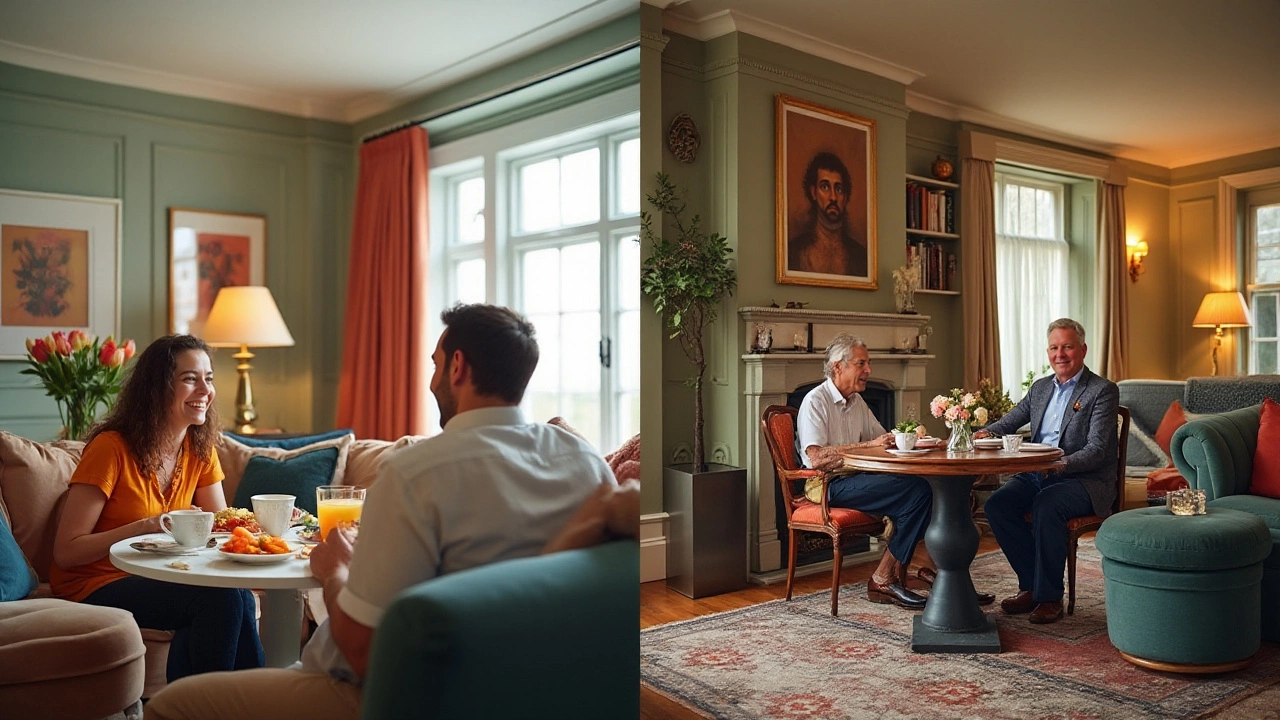Understanding Shared Ownership Homes: Are Shareholders True Property Owners?
 Jan, 18 2025
Jan, 18 2025
The idea of owning a piece of property by purchasing shares can be both intriguing and confusing. In the real estate world, shared ownership homes present a unique blend of financial investment and living arrangement. This method allows individuals to buy a share of a home, often making housing more attainable for those who might struggle with traditional buying methods.
However, the question remains: do these shares actually make you a true owner of the home? This article will embark on a journey to unravel this question by exploring the concept of shared ownership, its history, benefits, and the challenges it poses. By understanding these aspects, you can make informed decisions if you're considering stepping into the world of shared ownership.
- Defining Shared Ownership
- Historical Context and Popularity
- Benefits of Shared Ownership
- Challenges and Misconceptions
- Future of Shared Ownership Homes
Defining Shared Ownership
At its core, shared ownership homes bridge the gap between renting and full homeownership, easing the path for many aspiring homeowners. This unique arrangement allows an individual to purchase a percentage of a property, typically ranging between 25% and 75%, while paying rent on the remaining share. This carved-out niche in the real estate sector addresses a significant barrier to entry for potential homeowners who face prohibitive upfront costs in buying a property outright. Shared ownership is particularly popular in urban areas where property prices escalate rapidly, making full ownership a distant dream for many.
The shared ownership model emerged as a governmental response to the housing crisis, designed to make housing affordable for more people. It intertwines the benefits of renting, such as reduced responsibility for property maintenance, with the long-term security and investment potential of homeownership. Notably, this scheme also provides a step-by-step path towards complete ownership through a process known as 'staircasing,' where the buyer can gradually purchase additional shares until they own the property outright.
Unlike traditional methods, shared ownership involves a partnership, typically with a housing association, where responsibilities and costs are shared. This often includes a definitive leasehold period, generally up to 99 years, during which buyers enjoy the property much like their own. Yet, this distinctive model can lead to some misconceptions about the nature of ownership—are you truly an owner if you do not own the entire property?
According to The Guardian, "The idea of shared ownership is one of aid and mutual benefit, and it operates within a framework that balances risk and reward."
Assessing the positives, shared ownership provides an entry-point into the fiercely competitive real estate market, offering the chance of eventual full ownership. Yet, it's crucial to understand the potential pitfalls. Buyers must be aware of additional fees like ground rent and service charges, which must be factored into their housing budget. Unlike conventional ownership, shared owners may face restrictions on subletting, renovations, and even selling, dictated by terms set forth in the agreement with the housing association. Recognizing and navigating these potential limitations can make or break the experience for potential investors. These factors underscore the importance of understanding the real estate shares landscape before diving into a shared ownership agreement.
Historical Context and Popularity
Shared ownership as a concept finds its roots back in the late 20th century in the United Kingdom. It was born out of necessity during a time when housing prices began escalating beyond the reach of many potential homeowners. The aim was to create a bridge for those stuck in the liminal space between renting and buying. This innovative approach offered people an opportunity to have a stake in their home without having to shoulder the entire financial burden of a full mortgage. As it gained traction, shared ownership was lauded for its potential to make homeownership dreams a reality for first-time buyers. The appeal lay in its simplicity: investors only needed to purchase a percentage of the property (often starting at 25%) and then pay rent on the remaining share.
The popularity of this scheme has waxed and waned over the years, tied closely to the economic ebbs and flows. Notable spikes in interest often correlate with housing market booms when affordability becomes a pressing issue. The early 2000s marked a significant revival in shared ownership interest, as financial crises once again underscored the need for affordable housing solutions. With income growth not meeting the pace of spiraling property costs, shared ownership became a viable and popular option. The UK government also championed this initiative by providing support and incentives for both developers and buyers. This bolster allowed the concept to modernize, incorporating more sophisticated agreements and evolving to match the complexities of the housing market.
A noted survey by the National Housing Federation indicated that shared ownership homes could offer a doorway to many who thought homeownership was unattainable. In a quote from a recent report, "Shared ownership remains one of the most effective ways to make the property market accessible to many who are otherwise sidelined". This kind of endorsement by reputable institutions underscores the appeal and necessity of shared ownership in increasingly competitive housing markets. Looking across international borders, similar concepts have been adopted in places like Australia and parts of the United States, attesting to the global relevance of shared ownership homes. Today, as the appeal persists, it remains an integral part of urban planning conversations, bridging the gap between policy makers, developers, and aspiring homeowners.

Benefits of Shared Ownership
Shared ownership homes have steadily gained traction as an affordable housing solution, bridging the gap between renting and full homeownership. One of the unmistakable benefits of shared ownership homes is the potential for reduced initial financial outlay compared to traditional home buying. Buyers typically purchase an initial share, often ranging between 25% to 75% of the property value. This arrangement lowers the deposit requirement, enabling individuals—particularly first-time homebuyers—to enter the property market without the daunting burden of saving for a full deposit.
Moreover, shared ownership provides a form of financial security, allowing homeowners the possibility to eventually purchase higher equity stakes in their property, a practice known as staircasing. Staircasing is a flexible option, permitting owners to buy additional shares as funds allow, potentially leading to full ownership. This gradual investment mirrors a personal financial growth journey, as homeowners can steadily increase their stake without overwhelming financial pressure. Significantly, shared ownership also curtails monthly outgoings, with costs often being less than market rent for a fully owned property, offering economic stability and long-term savings.
The dynamics of shared ownership not only offer financial accessibility but also cultivate a sense of community and mutual support. In many shared ownership scenarios, housing associations manage the properties, providing maintenance services and ensuring communal facilities are well-kept. These associations are committed to affordable housing principles, often championing energy-efficient constructions and sustainable living environments, aligning with broader ecological responsibilities. An interesting insight from a study found that shared ownership homes also contribute to diverse socio-economic integration, lessening the divide between economic classes within housing developments.
"Shared ownership is not just a step onto the property ladder, but a sustainable housing model unfurling a tapestry of opportunities," notes a report by the National Housing Federation.
Additionally, shared ownership homes are typically governed under schemes that protect tenant rights, offering peace of mind to residents. The legal frameworks often ensure transparency and fairness in the process, with obligations and rights clearly outlined and regulated. This safeguards consumers, ensuring that the essence of co-ownership is preserved and respected, making real estate shares a reliable option for many. If we were to assume more data into viewing what others have succeeded with, shared ownership is usually more positively received among younger urban populations, as evidenced by a significant uptake noted in major cities.
Challenges and Misconceptions
Shared ownership homes are gaining popularity, yet the concept is laden with challenges and misconceptions that potential buyers must navigate. One of the biggest misunderstandings is the notion that purchasing a share automatically bestows the full rights of homeownership. In reality, owning shares in a shared ownership property often means you are a leaseholder rather than a freeholder. This distinction is crucial, as it involves differing levels of control and responsibility over the property.
Another common challenge relates to the financial intricacies of shared ownership. Many assume that having a share provides them with straightforward financial benefits akin to traditional homeownership. However, shared ownership schemes often involve a complex mix of mortgage payments, rent, and potential service charges. These expenses can fluctuate, especially if you plan to increase your share—an option known as staircasing. An important aspect to consider is the potential rise in property prices; if the value of the property increases, so does the cost of buying additional shares.
Misconceptions also arise around the flexibility and mobility related to shared ownership. While it might seem like a stepping stone towards full ownership or an easier entry into the property market, implications on selling such properties are frequently underestimated. The resale process can be cumbersome and restrictive, often requiring approval from the housing association and potential obligations to offer the property to other shared ownership buyers before it can be listed in the open market.
From a legal perspective, new buyers might underestimate the regulations and restrictions attached to shared ownership agreements. These can include rules on maintenance responsibilities and modifications within the property. Such clauses might limit the personalization of the space or impose mandatory shared costs for communal resources or repairs. "Purchasing through shared ownership confronts biases within the housing market," says Karen Young, a housing expert.
"Though it opens doors, it prompts buyers to carefully weigh commitments and contingencies—often beyond what traditional methods involve."
A critical factor to ponder is the long-term investment potential of shared ownership. While it's seen as an affordable way to get a footing in the housing market, some question its efficiency as a long-term financial investment. The overall equity buildup might be slower compared to full ownership, potentially affecting long-term financial net worth. Shared ownership properties may also appreciate at a different rate than the broader market, affecting both profit potential and investment appeal.
Understanding the breadth of these challenges and misconceptions is essential for anyone considering shared ownership homes. By clarifying what shared ownership truly entails, you set accurate expectations and prepare better strategies for an approach that aligns with your financial and personal goals.

Future of Shared Ownership Homes
Looking ahead, the landscape of shared ownership homes appears poised for significant transformation. As the housing market continuously evolves, shared ownership is increasingly seen as a viable solution to the housing affordability crisis, particularly in urban areas where property prices have soared to unprecedented levels. Governments and developers are recognizing the potential of shared ownership to bridge the gap between renting and full ownership. This model provides a balanced approach for those who wish to step onto the property ladder without the substantial financial burden of a full mortgage.
With housing shortages becoming a pressing issue, more projects are embracing the shared ownership model, often as part of sustainable urban developments. In cities known for their dense populations and high living costs, such as London and New York, shared ownership schemes are gaining momentum. These projects not only provide an opportunity to invest in real estate shares but also address the growing need for community-oriented living spaces that are accessible to a wider range of income levels.
"Shared ownership represents a critical piece of the housing puzzle, offering flexibility and accessibility that traditional models lack," said Jennifer Parker, head of the Housing Innovation Office.The future success of these programs depends heavily on governmental support and policy frameworks that incentivize developers to incorporate shared ownership options into their projects. In some regions, we can expect to see increased subsidies or tax incentives aimed at making these schemes more attractive and financially viable for developers and buyers alike.
Technological advancements will also play a role in shaping the future of shared ownership. With the rise of digital platforms, potential homeowners can now access information and resources at their fingertips, streamlining the process of purchasing and managing co-ownership properties. Blockchain technology, for instance, promises to offer security and transparency in property transactions, addressing one of the significant concerns shared ownership buyers often face.
Moreover, demographic shifts indicate that the demand for shared ownership will likely grow. As millennials and Gen Z enter the housing market, their preferences for flexible and community-oriented living, combined with challenging economic conditions, suggest that shared ownership could become a preferred method for home buying. These younger generations value sustainability and affordability, driving developers to innovate in design and functionality to meet these expectations.
The horizon for shared ownership is not without its challenges. Critics point to potential pitfalls, such as the maintenance of shared spaces and the complexities of managing shared ownership agreements. Yet, with continued evolution in policy, technology, and societal attitudes, shared ownership homes offer a promising pathway forward in tackling the housing crisis, ensuring homeownership remains within reach for future generations.